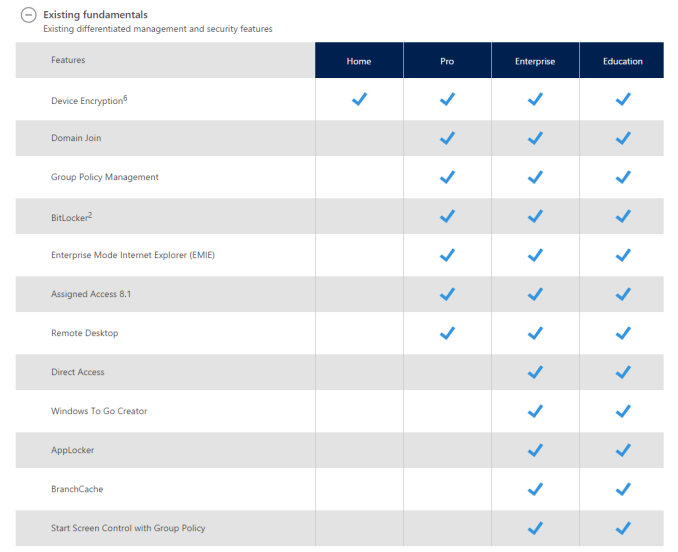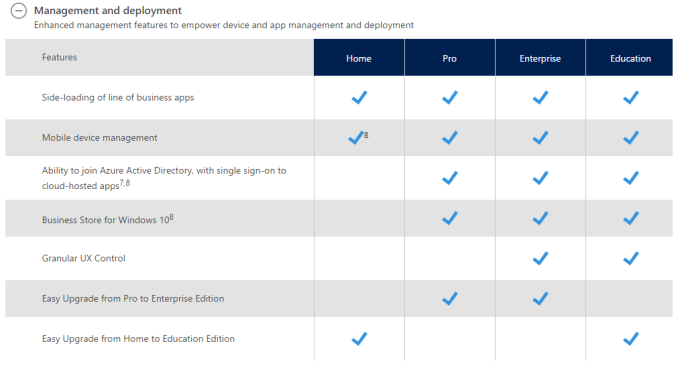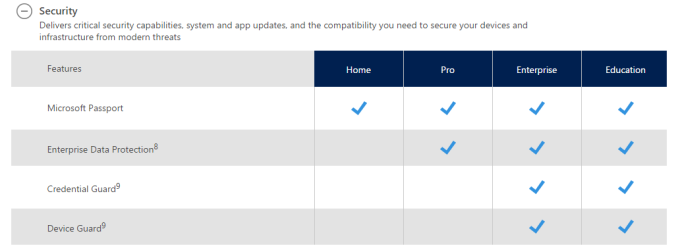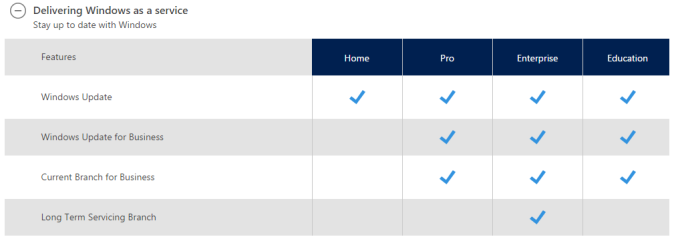Windows 10 Editions Compared
by Brett Howse on July 2, 2015 10:45 PM EST- Posted in
- Operating Systems
- Windows
- Microsoft
- Windows 10

Today Microsoft has finally created tables outlining what the different versions of the operating system are going to feature. It was back in May that they finally announced all of the versions of Windows 10 that are coming, but the actual features of each version was still a mystery. We could of course take an educated guess based on history, but as of today there is finally a list of all of the features broken down by version.
As a refresh, on the PC there are four basic versions. Home and Pro are the two that will be available for most people to purchase, and Enterprise is available to customers with volume licensing agreements. There is also an Education edition targeted towards that market.
As expected, Home has the fewest features available. Much like previous versions, there is no support to join an Active Directory domain, but that was not expected either. One thing that many users were hoping to see on Windows 10 Home is BitLocker support. BitLocker is Microsoft’s drive encryption suite, and Windows 10 Home does not have this unfortunately. There can still be encryption, but only as part of InstantGo, which was formerly known as Connected Standby. InstantGo is Connected Standby plus device encryption, and that is available to Home.
Windows 10 Pro keeps support for Remote Desktop, and it can of course join an Active Directory domain just as in prior versions. It also has access to the new Windows Update for Business service, but it must be kept on the Current Version branch.
Enterprise and Education are very similar, and both offer practically the same feature set. The one big difference is that Enterprise customers can opt into the Long Term Servicing Branch whereas Education customers cannot.
Pro, Enterprise, and Education also have access to the Business Store for Windows 10, and even the Home version supports side-loading of business apps.
One thing that is nice to see is that all versions feature support for Mobile Device Management, although the Home version will not have this support initially and it will be added at a later time.














66 Comments
View All Comments
Mark_gb - Sunday, July 5, 2015 - link
Home will be $119.Pro will be $199.
Wolfpup - Monday, July 6, 2015 - link
"Regular" versions of NT have never supported joining a domain. This dates back to at least 2001.I don't care about that (I don't join a domain even on a domain!) But bitlocker is awesome. Under Vista and 7 (?) it required "Ultimate" but thankfully moved down to "Pro" under 8.
boozed - Thursday, July 2, 2015 - link
Good to see the old delayed recycle bin is still available, and in all editions!peterfares - Friday, July 3, 2015 - link
Delayed recycle bin?CaedenV - Friday, July 3, 2015 - link
... I assume Pro/Ent get Virtualization support as well? What about Edu?vbmluis - Friday, July 3, 2015 - link
Have a Windows 7 Starter with the Windows 10 Free update notification, wonder if this is gonna have Home Edition for Free.Dahak - Friday, July 3, 2015 - link
Yes you will get Windows 10 Home, as the free upgradehttps://www.thurrott.com/windows/windows-10/3887/w...
dealcorn - Friday, July 3, 2015 - link
Are the license terms of Win 10 Home somewhere described? Does the Win 10 license permit limited portability features similar to those of an OEM license? Does a Win 10 license permit the use of a VM? Does your use of the word "yes" mean: yes I lose rights with the upgrade?TormDK - Friday, July 3, 2015 - link
From Microsofts newly revised Terms of use;Desktop Operating Systems
Device License
1. Customer may install one copy of the software on a Licensed Device or within a local virtual hardware system on a Licensed Device for each License it acquires.
2. Customer may use the software on up to two processors.
3. Local use is permitted for any user.
4. Remote use is permitted for the Primary User of the Licensed Device and for any other user from another Licensed Device or a Windows VDA Licensed Device.
5. Only one user may access and use the software at a time.
6. Customer may connect up to 20 devices to the Licensed Device for file sharing, printing, Internet Information Services, Internet Connection Sharing or telephony services.
7. An unlimited number of connections are allowed for KMS activation or similar technology.
Wolfpup - Monday, July 6, 2015 - link
Uhh...what's this 20 devices thing? Almost sounds like you can only have 20 devices on your home network lol